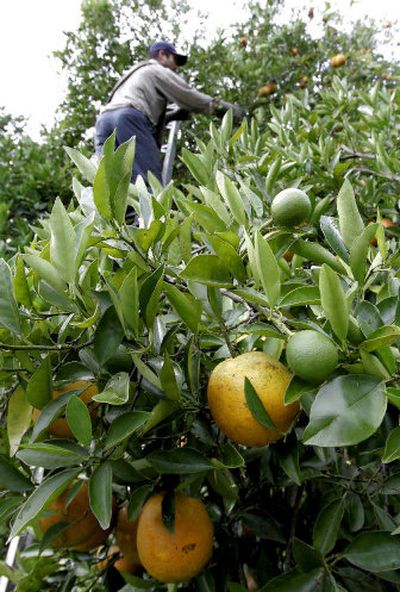Florida orange crop already going sour

ORLANDO, Fla. — It’s getting hard to grow oranges in the Sunshine State.
Monthslong droughts are broken by nasty hurricane seasons. Three diseases that kill and damage citrus trees and fruit continue to spread. Urban sprawl is taking over groves, and there are now fewer acres of trees than any time since 1988, when a wave of freezes crippled the industry.
Growers will pick the harvest’s first fruit in October, but some have already declared Florida in for a rotten citrus season. The price of future-delivery juice contracts on the New York exchange have reached record highs, and if the worst predictions of a crop shortage come true, the cost to consumers will follow suit.
Orange juice retail prices are already up 8 percent this year over last, and consumers have already responded by buying less (a 7 percent dip in gallons sold). The state is second only to Brazil in global orange juice production, and puts out more than 90 percent of all juice consumed in America.
“We’re just sitting here working as hard as we can to keep our head above water with all of the adversities that’ve been thrown our way,” said Philip C. “Flip” Gates Jr., vice president of Kanawha Groves in Fort Pierce.
Until hurricane season ends Nov. 30 and the potential for a winter freeze passes next spring, the best prediction anyone can offer of how many oranges Florida will produce this season is an educated guess. And, more than ever, the predictions have varied wildly.
Two private, well-respected analysts using complicated mathematical formulas and sampling techniques reached two very different conclusions. Kissimmee-based Citrus Consulting International put the orange harvest at 123 million boxes, a number the state hasn’t fallen to since the freak freezes two decades ago. Winter Garden-based Louis Dreyfus Citrus put the figure at 160 million boxes of oranges, each of which weighs 90 pounds.
Both are well short of the 220 million-box average Florida put out before the hurricanes whipped through in 2004 and 2005, but the high end would still better last season’s 150 million-box haul in July.
Elizabeth Steger, Citrus Consulting’s founder, said she thinks the difference owes to low numbers of fruit per tree.
“We have several live trees with no fruit,” Steger wrote in an email. “It was obvious to me that we had a smaller crop. I believe the last two hurricane seasons impacted the older tree production.”
The Florida Citrus Commission, based on an unscientific poll of its 12 members from various regions, is more optimistic, predicting 167 million boxes. That would be a reasonable recovery for growers feeling the squeeze.
The U.S. Department of Agriculture’s official projection, which is based on an extrapolation of its citrus tree count, doesn’t come out until Oct. 12.
But the tree census, released this month, amounted to more bad news. The USDA determined Florida had just 621,373 acres of citrus, a 17 percent drop from two years ago. A main contributor was a failed public policy that mandated the destruction of all trees within 1,900 feet of one testing positive for canker, a disease that causes fruit to blemish and drop prematurely.
Eight million commercial orange trees were destroyed over 10 years before the program was abandoned in January, when officials determined cutting them down couldn’t prevent the disease’s spread because hurricane winds already blew it all over Florida.
Bob Terry, an administrator at the USDA’s Florida field office, said the canker push was the single greatest cause of tree loss.
But worsening it, he said, were “land values shooting really, really high and groves being sold for developments,” as growers cash out and leave orange land behind.
Despite all of the troubles, the $9 billion Florida citrus industry can still rebound. Steger said the state may be in a low production cycle, which comes every four to six years.
Growers are trying to remain optimistic. Doug Bournique, executive vice president and general manager of Indian River Citrus League, said the size and sugar content of the fresh oranges grown in his region so far are better than recent years.